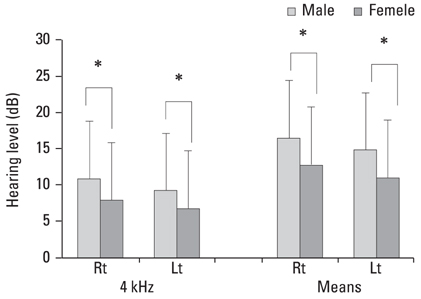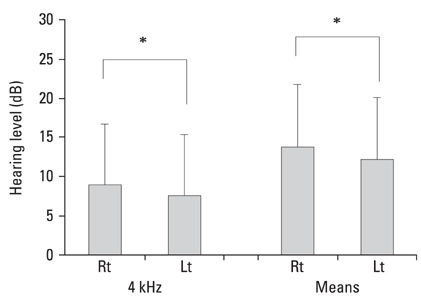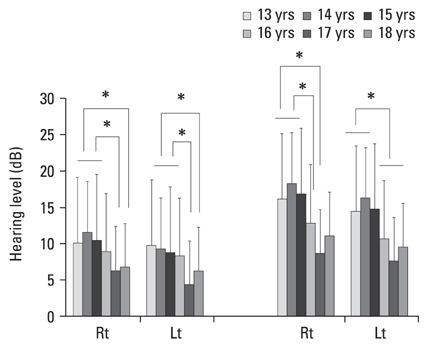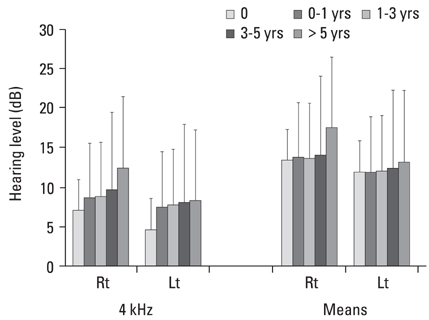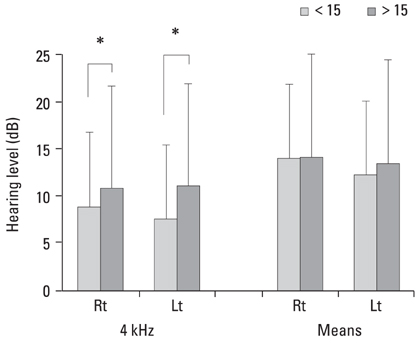Yonsei Med J.
2009 Dec;50(6):771-776. 10.3349/ymj.2009.50.6.771.
Hearing Threshold of Korean Adolescents Associated with the Use of Personal Music Players
- Affiliations
-
- 1Department of Otolaryngology, Masan Samsung Hospital, School of Medicine, Sungkyunkwan University, Masan, Korea.
- 2Department of Otorhinolaryngology and Head & Neck Surgery, College of Medicine, KyungHee University, Seoul, Korea. yeo2park@yahoo.co.kr
- 3Department of Otorhinolaryngology and Head & Neck Surgery, School of Medicine, Eulji University, Seoul, Korea.
- 4Bio ENT Clinics, Gwangju, Korea.
- KMID: 1777089
- DOI: http://doi.org/10.3349/ymj.2009.50.6.771
Abstract
- PURPOSE
Hearing loss can lead to a number of disabilities and can reduce quality of life. Noise-induced hearing losses have become more common among adolescents due to increased exposure to personal music players. We, therefore, investigated the use of personal music player among Korean adolescents and the relationship between hearing threshold and usage pattern of portable music players.
MATERIALS AND METHODS
A total of 490 adolescents were interviewed personally regarding their use of portable music players, including the time and type of player and the type of headphone used. Pure tone audiometry was performed in each subject.
RESULTS
Of the 490 subjects, 462 (94.3%) used personal music players and most of them have used the personal music player for 1-3 hours per day during 1-3 years. The most common type of portable music player was the MP3 player, and the most common type of headphone was the earphone (insert type). Significant elevations of hearing threshold were observed in males, in adolescents who had used portable music players for over 5 years, for those over 15 years in cumulative period and in those who had used earphones.
CONCLUSION
Portable music players can have a deleterious effect on hearing threshold in adolescents. To preserve hearing, adolescents should avoid using portable music players for long periods of time and should avoid using earphones.
Keyword
MeSH Terms
Figure
Reference
-
1. Magilvy K. Quality of life of hearing-impaired older women. Nurs Res. 1985. 34:140–144.
Article2. Mulrow CD, Aguilar C, Endicott JE, Tuley MR, Velez R, Charlip WS, et al. Quality-of-life changes and hearing impairment. A randomized trial. Ann Intern Med. 1990. 113:188–194.3. Lees RE, Roberts JH, Wald Z. Noise induced hearing loss and leisure activities of young people: a pilot study. Can J Public Health. 1985. 76:171–173.4. Blair JC, Hardegree D, Benson PV. Necessity and effectiveness of a hearing conservation program for elementary students. J Educ Audiol. 1996. 4:12–16.5. Niskar AS, Kieszak SM, Holmes AE, Esteban E, Rubin C, Brody DJ. Estimated prevalence of noise-induced hearing threshold shifts among children 6 to 19 years of age: the Third National Health and Nutrition Examination Survey, 1988-1994, United States. Pediatrics. 2001. 108:40–43.
Article6. Axelsson A, Jerson T. Noisy toys: a possible source of sensorineural hearing loss. Pediatrics. 1985. 76:574–578.
Article7. Jokitulppo JS, Björk EA, Akaan-Penttilä E. Estimated leisure noise exposure and hearing symptoms in Finnish teenagers. Scand Audiol. 1997. 26:257–262.
Article8. Turunen-Rice I, Flottorp G, Tvete O. A study of the possibility of acquiring noise-induced hearing loss by the use of personal cassette players (walkman). Scand Audiol Suppl. 1991. 34:133–144.9. American National Standards Institute. Maximum Permissible Ambient Noise Levels for Audiometric Test Rooms. ANSI S3.1-1999. 1999. New York: American National Standards Institute.10. Schmuzigert N, Fostiropoulos K, Probst R. Long-term assessment of auditory changes resulting from a single noise exposure associated with non-occupational activities. Int J Audiol. 2006. 45:46–54.
Article11. Centers for Disease Control and Prevention/NIOSH. Criteria for a Recommended Standard: Occupational Noise Exposure Revised Criteria. 1998. Cincinnati, Ohio: US Department of Health and Human Services.12. Kageyama T. Loudness in listening to music with portable headphone stereos. Percept Mot Skills. 1999. 88:423.
Article13. Daniel E. Noise and hearing loss: a review. J Sch Health. 2007. 77:225–231.
Article14. Klein BE, Cruickshanks KJ, Nondahl DM, Klein R, Dalton DS. Cataract and hearing loss in a population-based study: the Beaver Dam Studies. Am J Ophthalmol. 2001. 132:537–543.
Article15. Fligor BJ, Cox LC. Output levels of commercially available portable compact disc players and the potential risk to hearing. Ear Hear. 2004. 25:513–527.
Article16. Bronzaft A. The increase in noise pollution: what are the health effects? Nutr Health Rev. 1996. 78:2–7.17. Daniel E. Noise and hearing loss: a review. J Sch Health. 2007. 77:225–231.
Article18. Kaygusuz I, Oztürk A, Ustündağ B, Yalçin S. Role of free oxygen radicals in noise-related hearing impairment. Hear Res. 2001. 162:43–47.
Article19. Kolkhorst FW, Smaldino JJ, Wolf SC, Battani LR, Plakke BL, Huddleston S, et al. Influence of fitness on susceptibility to noise-induced temporary threshold shift. Med Sci Sports Exerc. 1998. 30:289–293.
Article20. Lawrence HP, Garcia RI, Essick GK, Hawkins R, Krall EA, Spiro A 3rd, et al. A longitudinal study of the association between tooth loss and age-related hearing loss. Spec Care Dentist. 2001. 21:129–140.
Article21. Ferrite S, Santana V. Joint effects of smoking, noise exposure and age on hearing loss. Occup Med (Lond). 2005. 55:48–53.
Article
- Full Text Links
- Actions
-
Cited
- CITED
-
- Close
- Share
- Similar articles
-
- Effects of the Personal Stereo System on Hearing in Adolescents
- Analysis of Factors Affecting Output Levels and Frequencies of MP3 Players
- Personal Listening Device Use Habits, Listening Belief, and Perceived Change in Hearing Among Adolescents
- A Follow-up Study on the Personal Noise Exposed Dose and Hearing Loss
- Comparisons of dental arches and crowdings between musical wind-instrument players groups and non-wind instrument players group

